Financial Decision Making Strategies and Analysis for Skanska Plc
VerifiedAdded on 2021/10/14
|16
|4064
|155
Report
AI Summary
This report provides a comprehensive analysis of financial decision-making within Skanska Plc, a prominent construction and project development company. It begins by exploring the significance of accounting functions, detailing their role in providing financial information, measuring performance, controlling expenditure, and reporting on financial activities. The report then delves into the importance of financial functions, including financial planning, control, effective fund utilization, and cash flow forecasting. It further examines the specific duties and roles of both accounting and financial functions within Skanska, such as maintaining stakeholder relationships, providing information on receivables and payables, wealth maximization, and visualizing financial conditions through various statements. The report concludes by determining financial ratios of Skanska Plc and evaluating its overall performance.

Financial Decision Making
1 | P a g e
1 | P a g e
Paraphrase This Document
Need a fresh take? Get an instant paraphrase of this document with our AI Paraphraser
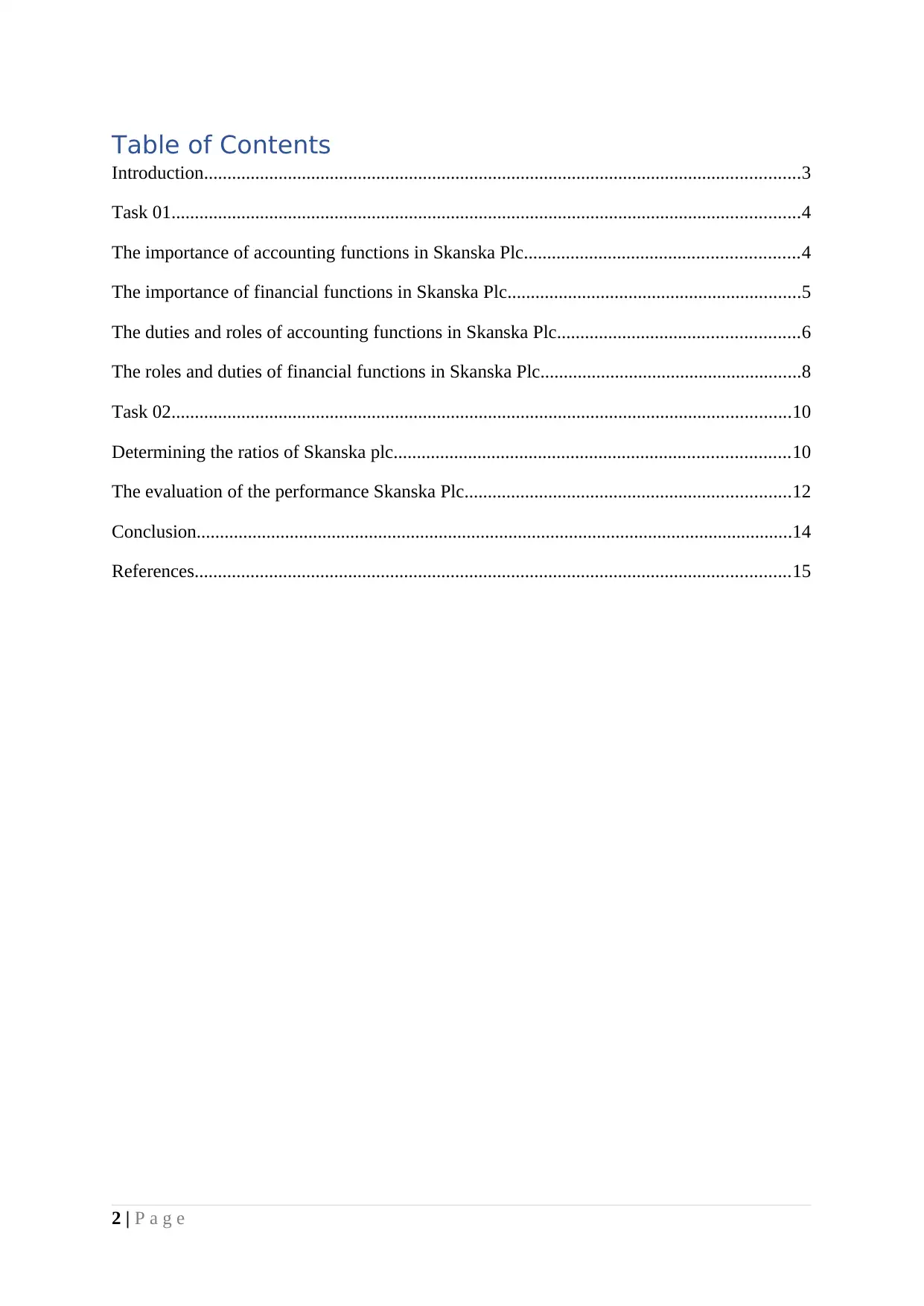
Table of Contents
Introduction................................................................................................................................3
Task 01.......................................................................................................................................4
The importance of accounting functions in Skanska Plc...........................................................4
The importance of financial functions in Skanska Plc...............................................................5
The duties and roles of accounting functions in Skanska Plc....................................................6
The roles and duties of financial functions in Skanska Plc........................................................8
Task 02.....................................................................................................................................10
Determining the ratios of Skanska plc.....................................................................................10
The evaluation of the performance Skanska Plc......................................................................12
Conclusion................................................................................................................................14
References................................................................................................................................15
2 | P a g e
Introduction................................................................................................................................3
Task 01.......................................................................................................................................4
The importance of accounting functions in Skanska Plc...........................................................4
The importance of financial functions in Skanska Plc...............................................................5
The duties and roles of accounting functions in Skanska Plc....................................................6
The roles and duties of financial functions in Skanska Plc........................................................8
Task 02.....................................................................................................................................10
Determining the ratios of Skanska plc.....................................................................................10
The evaluation of the performance Skanska Plc......................................................................12
Conclusion................................................................................................................................14
References................................................................................................................................15
2 | P a g e
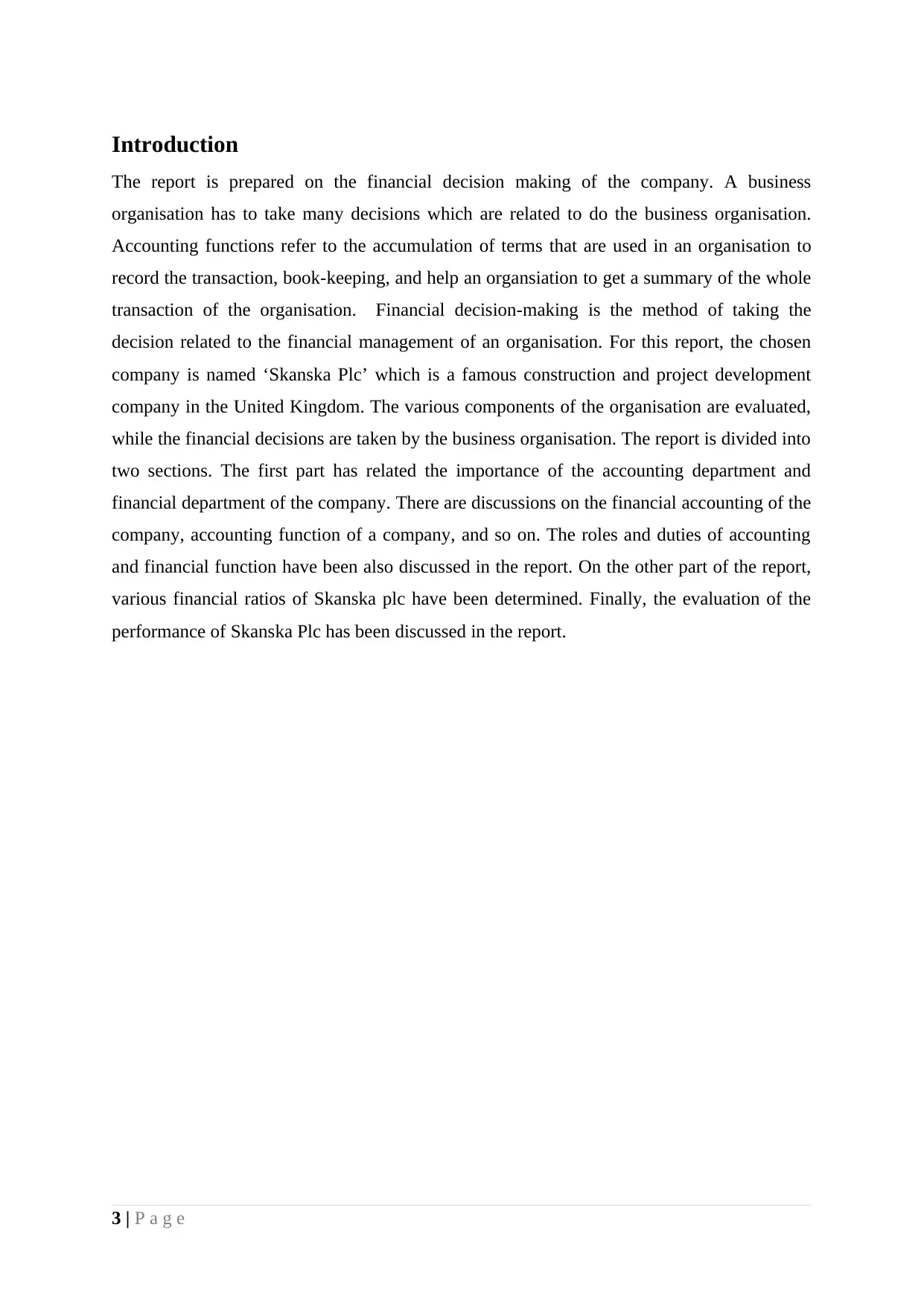
Introduction
The report is prepared on the financial decision making of the company. A business
organisation has to take many decisions which are related to do the business organisation.
Accounting functions refer to the accumulation of terms that are used in an organisation to
record the transaction, book-keeping, and help an organsiation to get a summary of the whole
transaction of the organisation. Financial decision-making is the method of taking the
decision related to the financial management of an organisation. For this report, the chosen
company is named ‘Skanska Plc’ which is a famous construction and project development
company in the United Kingdom. The various components of the organisation are evaluated,
while the financial decisions are taken by the business organisation. The report is divided into
two sections. The first part has related the importance of the accounting department and
financial department of the company. There are discussions on the financial accounting of the
company, accounting function of a company, and so on. The roles and duties of accounting
and financial function have been also discussed in the report. On the other part of the report,
various financial ratios of Skanska plc have been determined. Finally, the evaluation of the
performance of Skanska Plc has been discussed in the report.
3 | P a g e
The report is prepared on the financial decision making of the company. A business
organisation has to take many decisions which are related to do the business organisation.
Accounting functions refer to the accumulation of terms that are used in an organisation to
record the transaction, book-keeping, and help an organsiation to get a summary of the whole
transaction of the organisation. Financial decision-making is the method of taking the
decision related to the financial management of an organisation. For this report, the chosen
company is named ‘Skanska Plc’ which is a famous construction and project development
company in the United Kingdom. The various components of the organisation are evaluated,
while the financial decisions are taken by the business organisation. The report is divided into
two sections. The first part has related the importance of the accounting department and
financial department of the company. There are discussions on the financial accounting of the
company, accounting function of a company, and so on. The roles and duties of accounting
and financial function have been also discussed in the report. On the other part of the report,
various financial ratios of Skanska plc have been determined. Finally, the evaluation of the
performance of Skanska Plc has been discussed in the report.
3 | P a g e
⊘ This is a preview!⊘
Do you want full access?
Subscribe today to unlock all pages.

Trusted by 1+ million students worldwide
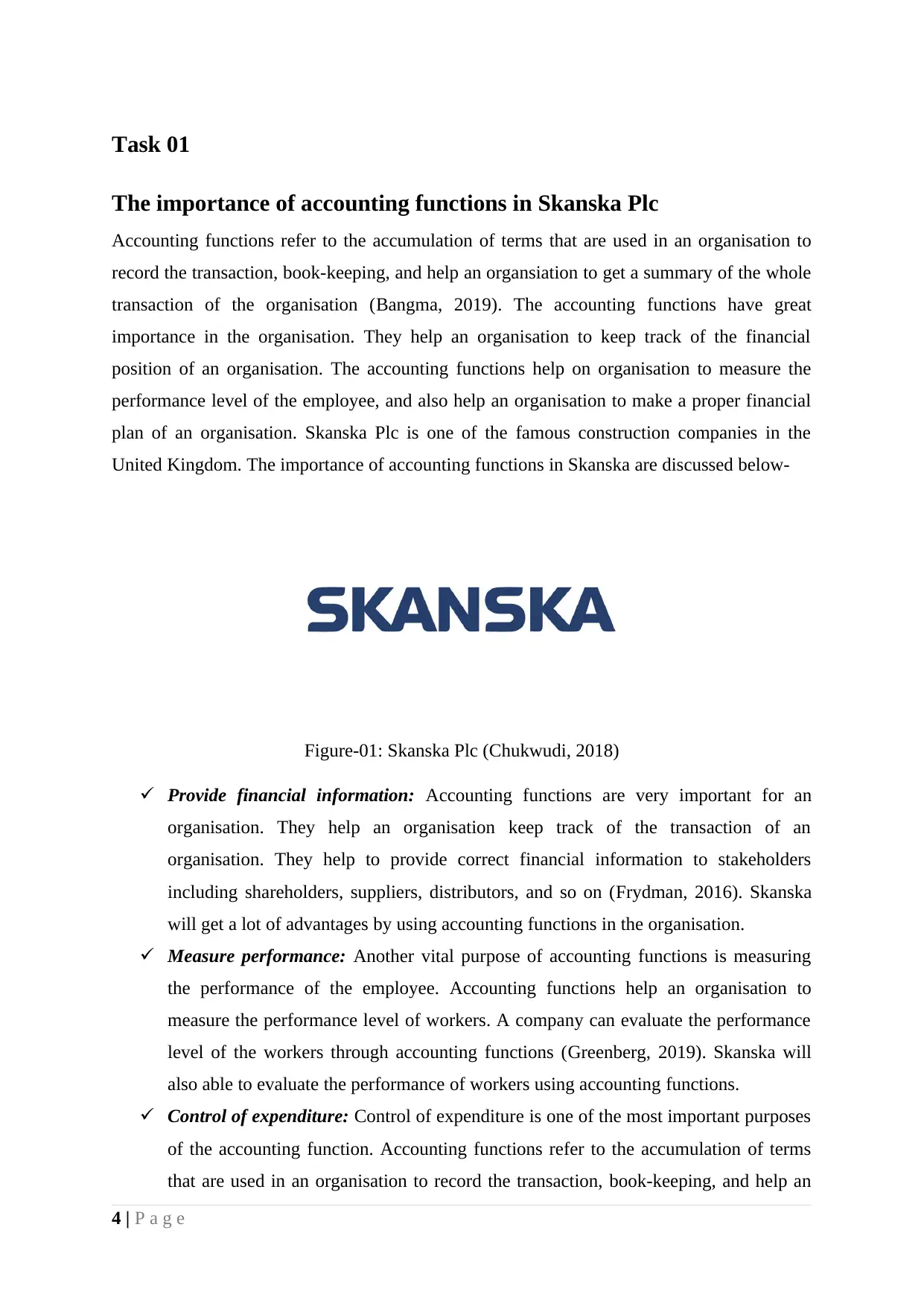
Task 01
The importance of accounting functions in Skanska Plc
Accounting functions refer to the accumulation of terms that are used in an organisation to
record the transaction, book-keeping, and help an organsiation to get a summary of the whole
transaction of the organisation (Bangma, 2019). The accounting functions have great
importance in the organisation. They help an organisation to keep track of the financial
position of an organisation. The accounting functions help on organisation to measure the
performance level of the employee, and also help an organisation to make a proper financial
plan of an organisation. Skanska Plc is one of the famous construction companies in the
United Kingdom. The importance of accounting functions in Skanska are discussed below-
Figure-01: Skanska Plc (Chukwudi, 2018)
Provide financial information: Accounting functions are very important for an
organisation. They help an organisation keep track of the transaction of an
organisation. They help to provide correct financial information to stakeholders
including shareholders, suppliers, distributors, and so on (Frydman, 2016). Skanska
will get a lot of advantages by using accounting functions in the organisation.
Measure performance: Another vital purpose of accounting functions is measuring
the performance of the employee. Accounting functions help an organisation to
measure the performance level of workers. A company can evaluate the performance
level of the workers through accounting functions (Greenberg, 2019). Skanska will
also able to evaluate the performance of workers using accounting functions.
Control of expenditure: Control of expenditure is one of the most important purposes
of the accounting function. Accounting functions refer to the accumulation of terms
that are used in an organisation to record the transaction, book-keeping, and help an
4 | P a g e
The importance of accounting functions in Skanska Plc
Accounting functions refer to the accumulation of terms that are used in an organisation to
record the transaction, book-keeping, and help an organsiation to get a summary of the whole
transaction of the organisation (Bangma, 2019). The accounting functions have great
importance in the organisation. They help an organisation to keep track of the financial
position of an organisation. The accounting functions help on organisation to measure the
performance level of the employee, and also help an organisation to make a proper financial
plan of an organisation. Skanska Plc is one of the famous construction companies in the
United Kingdom. The importance of accounting functions in Skanska are discussed below-
Figure-01: Skanska Plc (Chukwudi, 2018)
Provide financial information: Accounting functions are very important for an
organisation. They help an organisation keep track of the transaction of an
organisation. They help to provide correct financial information to stakeholders
including shareholders, suppliers, distributors, and so on (Frydman, 2016). Skanska
will get a lot of advantages by using accounting functions in the organisation.
Measure performance: Another vital purpose of accounting functions is measuring
the performance of the employee. Accounting functions help an organisation to
measure the performance level of workers. A company can evaluate the performance
level of the workers through accounting functions (Greenberg, 2019). Skanska will
also able to evaluate the performance of workers using accounting functions.
Control of expenditure: Control of expenditure is one of the most important purposes
of the accounting function. Accounting functions refer to the accumulation of terms
that are used in an organisation to record the transaction, book-keeping, and help an
4 | P a g e
Paraphrase This Document
Need a fresh take? Get an instant paraphrase of this document with our AI Paraphraser
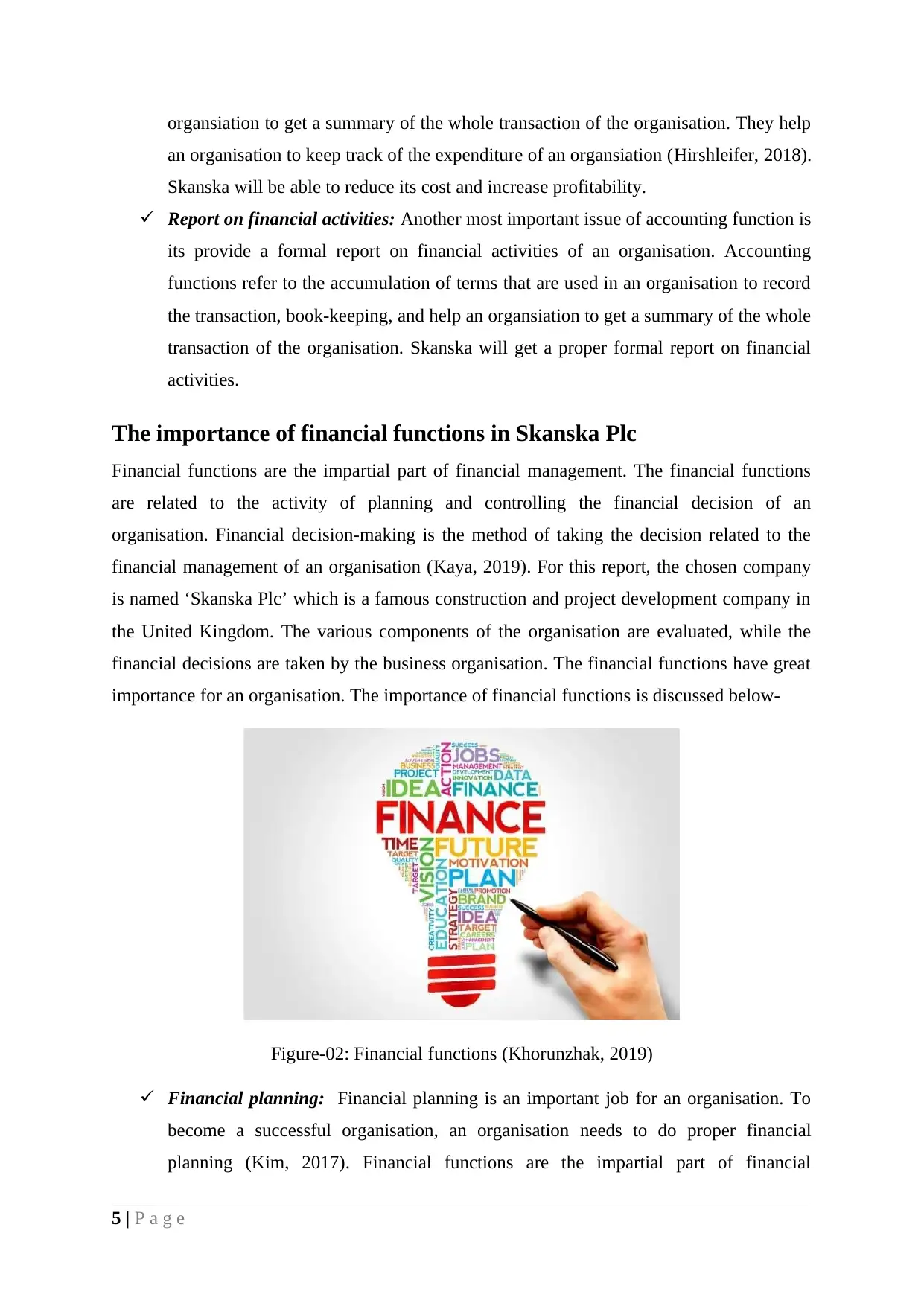
organsiation to get a summary of the whole transaction of the organisation. They help
an organisation to keep track of the expenditure of an organsiation (Hirshleifer, 2018).
Skanska will be able to reduce its cost and increase profitability.
Report on financial activities: Another most important issue of accounting function is
its provide a formal report on financial activities of an organisation. Accounting
functions refer to the accumulation of terms that are used in an organisation to record
the transaction, book-keeping, and help an organsiation to get a summary of the whole
transaction of the organisation. Skanska will get a proper formal report on financial
activities.
The importance of financial functions in Skanska Plc
Financial functions are the impartial part of financial management. The financial functions
are related to the activity of planning and controlling the financial decision of an
organisation. Financial decision-making is the method of taking the decision related to the
financial management of an organisation (Kaya, 2019). For this report, the chosen company
is named ‘Skanska Plc’ which is a famous construction and project development company in
the United Kingdom. The various components of the organisation are evaluated, while the
financial decisions are taken by the business organisation. The financial functions have great
importance for an organisation. The importance of financial functions is discussed below-
Figure-02: Financial functions (Khorunzhak, 2019)
Financial planning: Financial planning is an important job for an organisation. To
become a successful organisation, an organisation needs to do proper financial
planning (Kim, 2017). Financial functions are the impartial part of financial
5 | P a g e
an organisation to keep track of the expenditure of an organsiation (Hirshleifer, 2018).
Skanska will be able to reduce its cost and increase profitability.
Report on financial activities: Another most important issue of accounting function is
its provide a formal report on financial activities of an organisation. Accounting
functions refer to the accumulation of terms that are used in an organisation to record
the transaction, book-keeping, and help an organsiation to get a summary of the whole
transaction of the organisation. Skanska will get a proper formal report on financial
activities.
The importance of financial functions in Skanska Plc
Financial functions are the impartial part of financial management. The financial functions
are related to the activity of planning and controlling the financial decision of an
organisation. Financial decision-making is the method of taking the decision related to the
financial management of an organisation (Kaya, 2019). For this report, the chosen company
is named ‘Skanska Plc’ which is a famous construction and project development company in
the United Kingdom. The various components of the organisation are evaluated, while the
financial decisions are taken by the business organisation. The financial functions have great
importance for an organisation. The importance of financial functions is discussed below-
Figure-02: Financial functions (Khorunzhak, 2019)
Financial planning: Financial planning is an important job for an organisation. To
become a successful organisation, an organisation needs to do proper financial
planning (Kim, 2017). Financial functions are the impartial part of financial
5 | P a g e
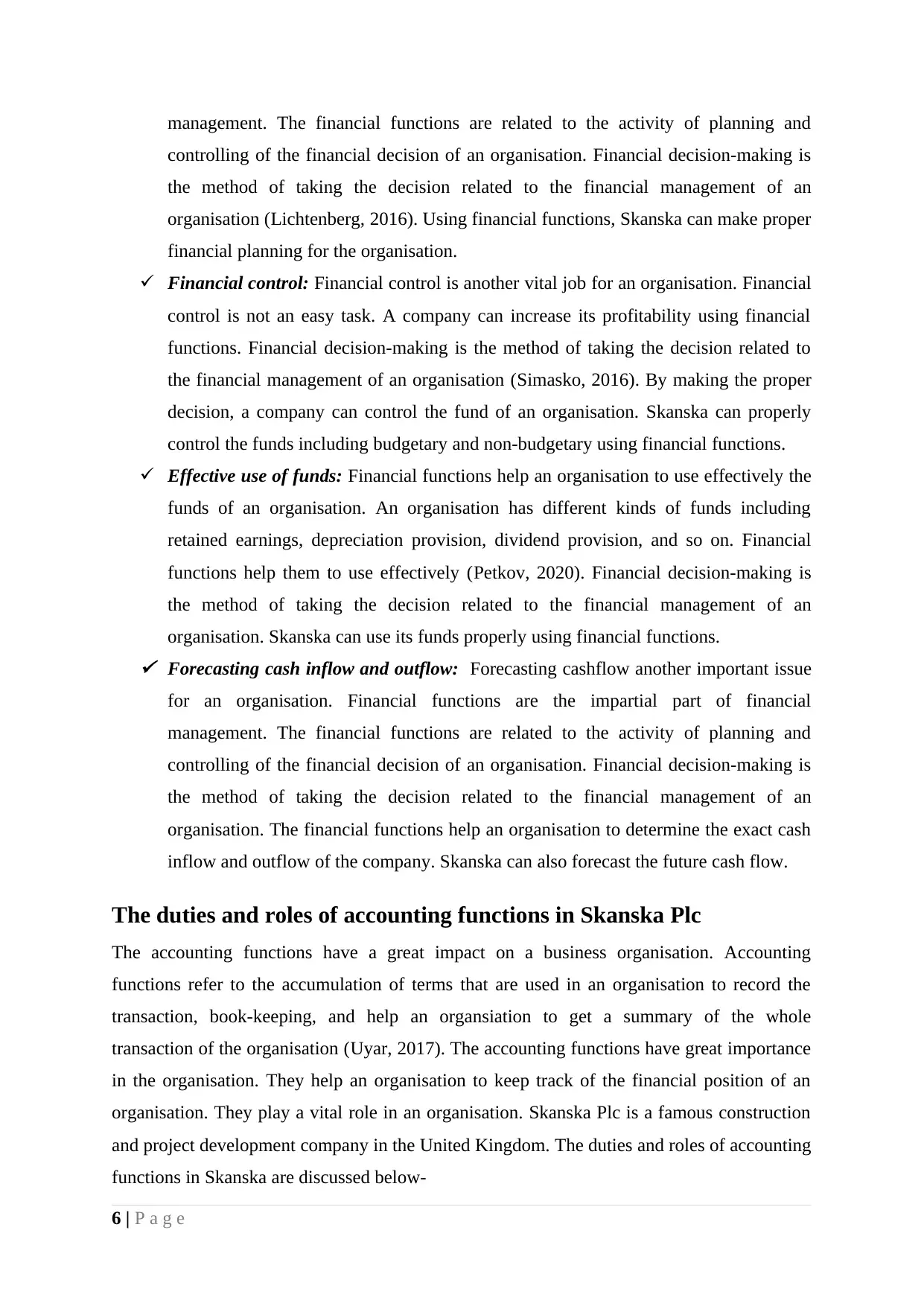
management. The financial functions are related to the activity of planning and
controlling of the financial decision of an organisation. Financial decision-making is
the method of taking the decision related to the financial management of an
organisation (Lichtenberg, 2016). Using financial functions, Skanska can make proper
financial planning for the organisation.
Financial control: Financial control is another vital job for an organisation. Financial
control is not an easy task. A company can increase its profitability using financial
functions. Financial decision-making is the method of taking the decision related to
the financial management of an organisation (Simasko, 2016). By making the proper
decision, a company can control the fund of an organisation. Skanska can properly
control the funds including budgetary and non-budgetary using financial functions.
Effective use of funds: Financial functions help an organisation to use effectively the
funds of an organisation. An organisation has different kinds of funds including
retained earnings, depreciation provision, dividend provision, and so on. Financial
functions help them to use effectively (Petkov, 2020). Financial decision-making is
the method of taking the decision related to the financial management of an
organisation. Skanska can use its funds properly using financial functions. Forecasting cash inflow and outflow: Forecasting cashflow another important issue
for an organisation. Financial functions are the impartial part of financial
management. The financial functions are related to the activity of planning and
controlling of the financial decision of an organisation. Financial decision-making is
the method of taking the decision related to the financial management of an
organisation. The financial functions help an organisation to determine the exact cash
inflow and outflow of the company. Skanska can also forecast the future cash flow.
The duties and roles of accounting functions in Skanska Plc
The accounting functions have a great impact on a business organisation. Accounting
functions refer to the accumulation of terms that are used in an organisation to record the
transaction, book-keeping, and help an organsiation to get a summary of the whole
transaction of the organisation (Uyar, 2017). The accounting functions have great importance
in the organisation. They help an organisation to keep track of the financial position of an
organisation. They play a vital role in an organisation. Skanska Plc is a famous construction
and project development company in the United Kingdom. The duties and roles of accounting
functions in Skanska are discussed below-
6 | P a g e
controlling of the financial decision of an organisation. Financial decision-making is
the method of taking the decision related to the financial management of an
organisation (Lichtenberg, 2016). Using financial functions, Skanska can make proper
financial planning for the organisation.
Financial control: Financial control is another vital job for an organisation. Financial
control is not an easy task. A company can increase its profitability using financial
functions. Financial decision-making is the method of taking the decision related to
the financial management of an organisation (Simasko, 2016). By making the proper
decision, a company can control the fund of an organisation. Skanska can properly
control the funds including budgetary and non-budgetary using financial functions.
Effective use of funds: Financial functions help an organisation to use effectively the
funds of an organisation. An organisation has different kinds of funds including
retained earnings, depreciation provision, dividend provision, and so on. Financial
functions help them to use effectively (Petkov, 2020). Financial decision-making is
the method of taking the decision related to the financial management of an
organisation. Skanska can use its funds properly using financial functions. Forecasting cash inflow and outflow: Forecasting cashflow another important issue
for an organisation. Financial functions are the impartial part of financial
management. The financial functions are related to the activity of planning and
controlling of the financial decision of an organisation. Financial decision-making is
the method of taking the decision related to the financial management of an
organisation. The financial functions help an organisation to determine the exact cash
inflow and outflow of the company. Skanska can also forecast the future cash flow.
The duties and roles of accounting functions in Skanska Plc
The accounting functions have a great impact on a business organisation. Accounting
functions refer to the accumulation of terms that are used in an organisation to record the
transaction, book-keeping, and help an organsiation to get a summary of the whole
transaction of the organisation (Uyar, 2017). The accounting functions have great importance
in the organisation. They help an organisation to keep track of the financial position of an
organisation. They play a vital role in an organisation. Skanska Plc is a famous construction
and project development company in the United Kingdom. The duties and roles of accounting
functions in Skanska are discussed below-
6 | P a g e
⊘ This is a preview!⊘
Do you want full access?
Subscribe today to unlock all pages.

Trusted by 1+ million students worldwide
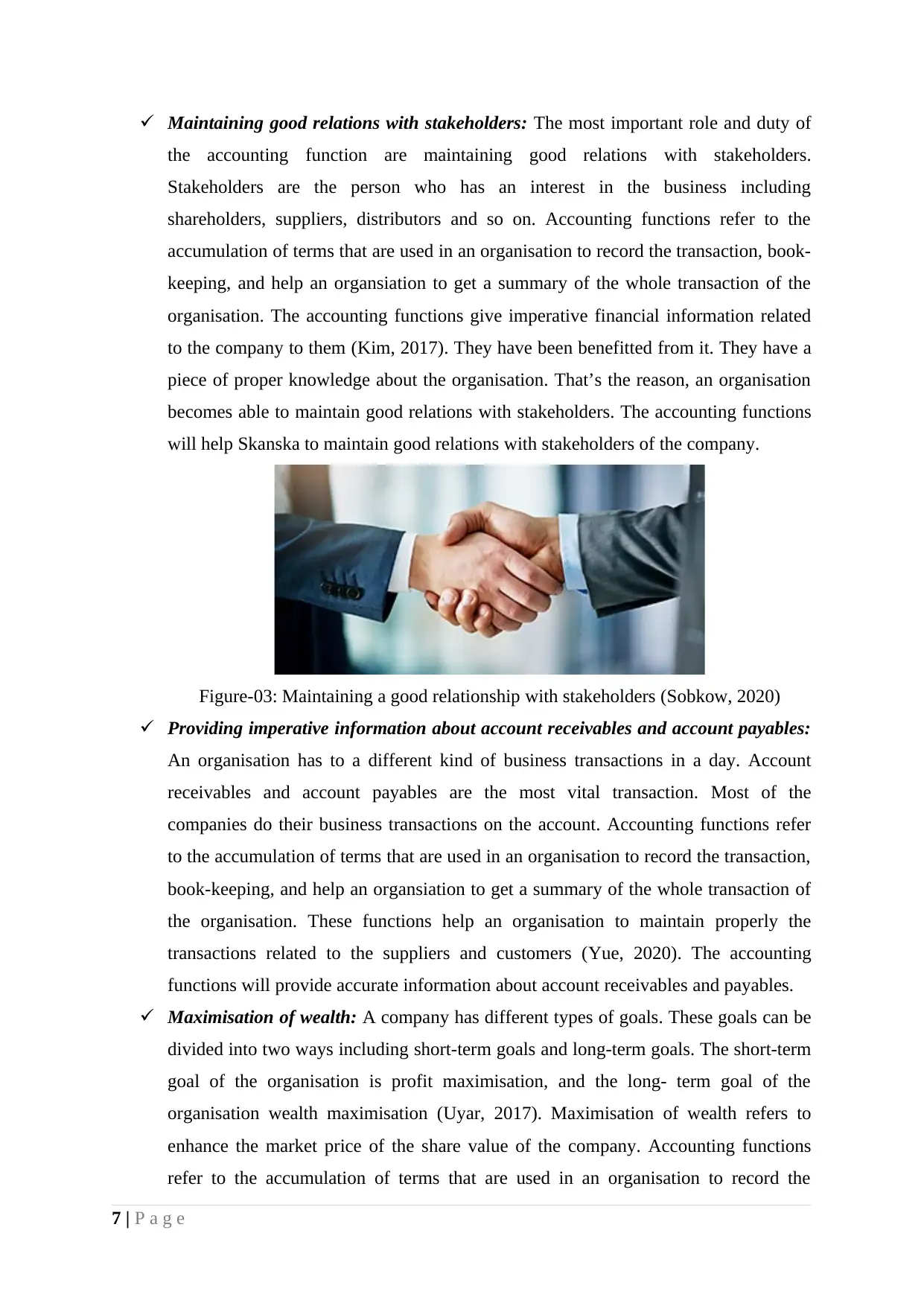
Maintaining good relations with stakeholders: The most important role and duty of
the accounting function are maintaining good relations with stakeholders.
Stakeholders are the person who has an interest in the business including
shareholders, suppliers, distributors and so on. Accounting functions refer to the
accumulation of terms that are used in an organisation to record the transaction, book-
keeping, and help an organsiation to get a summary of the whole transaction of the
organisation. The accounting functions give imperative financial information related
to the company to them (Kim, 2017). They have been benefitted from it. They have a
piece of proper knowledge about the organisation. That’s the reason, an organisation
becomes able to maintain good relations with stakeholders. The accounting functions
will help Skanska to maintain good relations with stakeholders of the company.
Figure-03: Maintaining a good relationship with stakeholders (Sobkow, 2020)
Providing imperative information about account receivables and account payables:
An organisation has to a different kind of business transactions in a day. Account
receivables and account payables are the most vital transaction. Most of the
companies do their business transactions on the account. Accounting functions refer
to the accumulation of terms that are used in an organisation to record the transaction,
book-keeping, and help an organsiation to get a summary of the whole transaction of
the organisation. These functions help an organisation to maintain properly the
transactions related to the suppliers and customers (Yue, 2020). The accounting
functions will provide accurate information about account receivables and payables.
Maximisation of wealth: A company has different types of goals. These goals can be
divided into two ways including short-term goals and long-term goals. The short-term
goal of the organisation is profit maximisation, and the long- term goal of the
organisation wealth maximisation (Uyar, 2017). Maximisation of wealth refers to
enhance the market price of the share value of the company. Accounting functions
refer to the accumulation of terms that are used in an organisation to record the
7 | P a g e
the accounting function are maintaining good relations with stakeholders.
Stakeholders are the person who has an interest in the business including
shareholders, suppliers, distributors and so on. Accounting functions refer to the
accumulation of terms that are used in an organisation to record the transaction, book-
keeping, and help an organsiation to get a summary of the whole transaction of the
organisation. The accounting functions give imperative financial information related
to the company to them (Kim, 2017). They have been benefitted from it. They have a
piece of proper knowledge about the organisation. That’s the reason, an organisation
becomes able to maintain good relations with stakeholders. The accounting functions
will help Skanska to maintain good relations with stakeholders of the company.
Figure-03: Maintaining a good relationship with stakeholders (Sobkow, 2020)
Providing imperative information about account receivables and account payables:
An organisation has to a different kind of business transactions in a day. Account
receivables and account payables are the most vital transaction. Most of the
companies do their business transactions on the account. Accounting functions refer
to the accumulation of terms that are used in an organisation to record the transaction,
book-keeping, and help an organsiation to get a summary of the whole transaction of
the organisation. These functions help an organisation to maintain properly the
transactions related to the suppliers and customers (Yue, 2020). The accounting
functions will provide accurate information about account receivables and payables.
Maximisation of wealth: A company has different types of goals. These goals can be
divided into two ways including short-term goals and long-term goals. The short-term
goal of the organisation is profit maximisation, and the long- term goal of the
organisation wealth maximisation (Uyar, 2017). Maximisation of wealth refers to
enhance the market price of the share value of the company. Accounting functions
refer to the accumulation of terms that are used in an organisation to record the
7 | P a g e
Paraphrase This Document
Need a fresh take? Get an instant paraphrase of this document with our AI Paraphraser
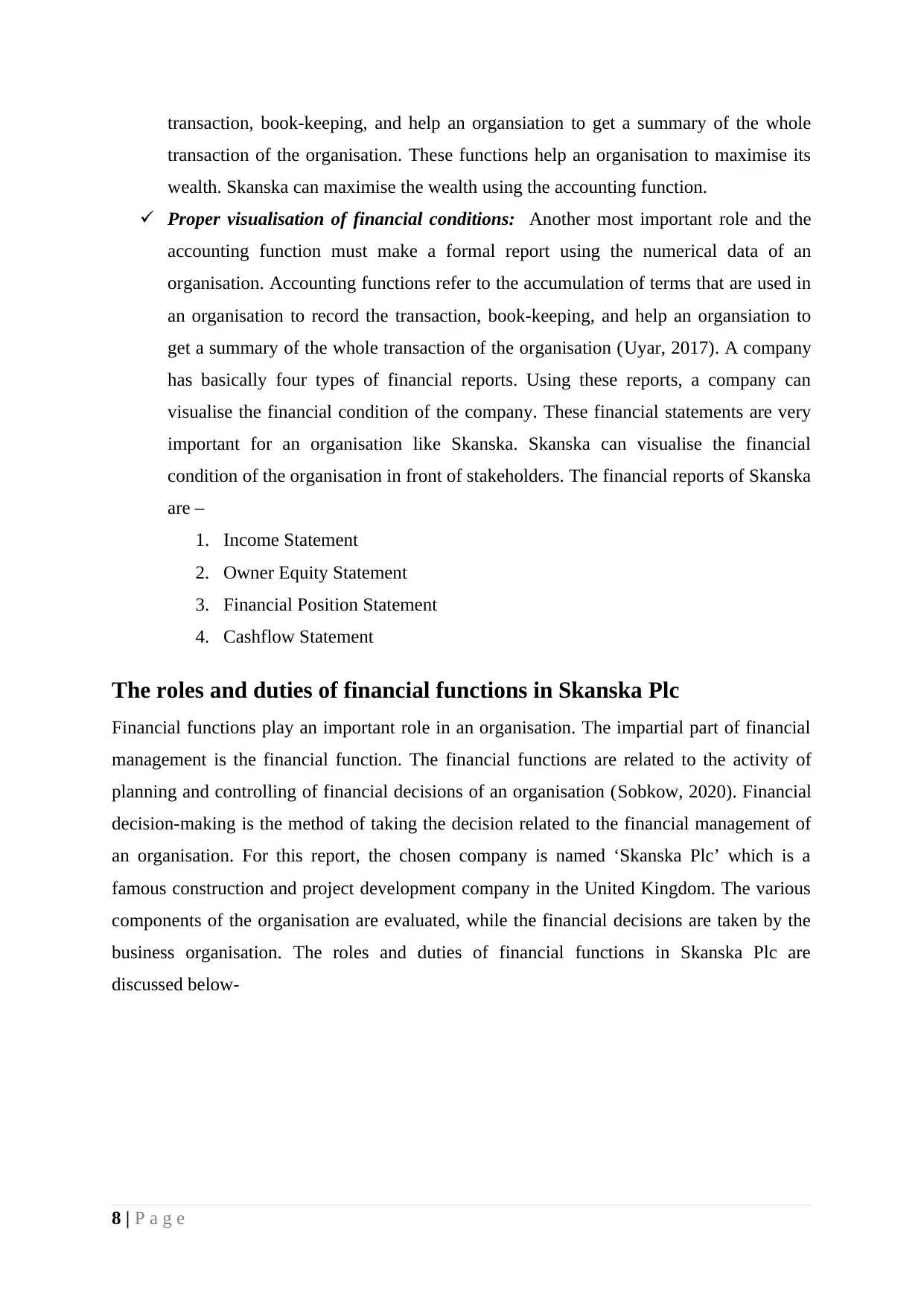
transaction, book-keeping, and help an organsiation to get a summary of the whole
transaction of the organisation. These functions help an organisation to maximise its
wealth. Skanska can maximise the wealth using the accounting function.
Proper visualisation of financial conditions: Another most important role and the
accounting function must make a formal report using the numerical data of an
organisation. Accounting functions refer to the accumulation of terms that are used in
an organisation to record the transaction, book-keeping, and help an organsiation to
get a summary of the whole transaction of the organisation (Uyar, 2017). A company
has basically four types of financial reports. Using these reports, a company can
visualise the financial condition of the company. These financial statements are very
important for an organisation like Skanska. Skanska can visualise the financial
condition of the organisation in front of stakeholders. The financial reports of Skanska
are –
1. Income Statement
2. Owner Equity Statement
3. Financial Position Statement
4. Cashflow Statement
The roles and duties of financial functions in Skanska Plc
Financial functions play an important role in an organisation. The impartial part of financial
management is the financial function. The financial functions are related to the activity of
planning and controlling of financial decisions of an organisation (Sobkow, 2020). Financial
decision-making is the method of taking the decision related to the financial management of
an organisation. For this report, the chosen company is named ‘Skanska Plc’ which is a
famous construction and project development company in the United Kingdom. The various
components of the organisation are evaluated, while the financial decisions are taken by the
business organisation. The roles and duties of financial functions in Skanska Plc are
discussed below-
8 | P a g e
transaction of the organisation. These functions help an organisation to maximise its
wealth. Skanska can maximise the wealth using the accounting function.
Proper visualisation of financial conditions: Another most important role and the
accounting function must make a formal report using the numerical data of an
organisation. Accounting functions refer to the accumulation of terms that are used in
an organisation to record the transaction, book-keeping, and help an organsiation to
get a summary of the whole transaction of the organisation (Uyar, 2017). A company
has basically four types of financial reports. Using these reports, a company can
visualise the financial condition of the company. These financial statements are very
important for an organisation like Skanska. Skanska can visualise the financial
condition of the organisation in front of stakeholders. The financial reports of Skanska
are –
1. Income Statement
2. Owner Equity Statement
3. Financial Position Statement
4. Cashflow Statement
The roles and duties of financial functions in Skanska Plc
Financial functions play an important role in an organisation. The impartial part of financial
management is the financial function. The financial functions are related to the activity of
planning and controlling of financial decisions of an organisation (Sobkow, 2020). Financial
decision-making is the method of taking the decision related to the financial management of
an organisation. For this report, the chosen company is named ‘Skanska Plc’ which is a
famous construction and project development company in the United Kingdom. The various
components of the organisation are evaluated, while the financial decisions are taken by the
business organisation. The roles and duties of financial functions in Skanska Plc are
discussed below-
8 | P a g e
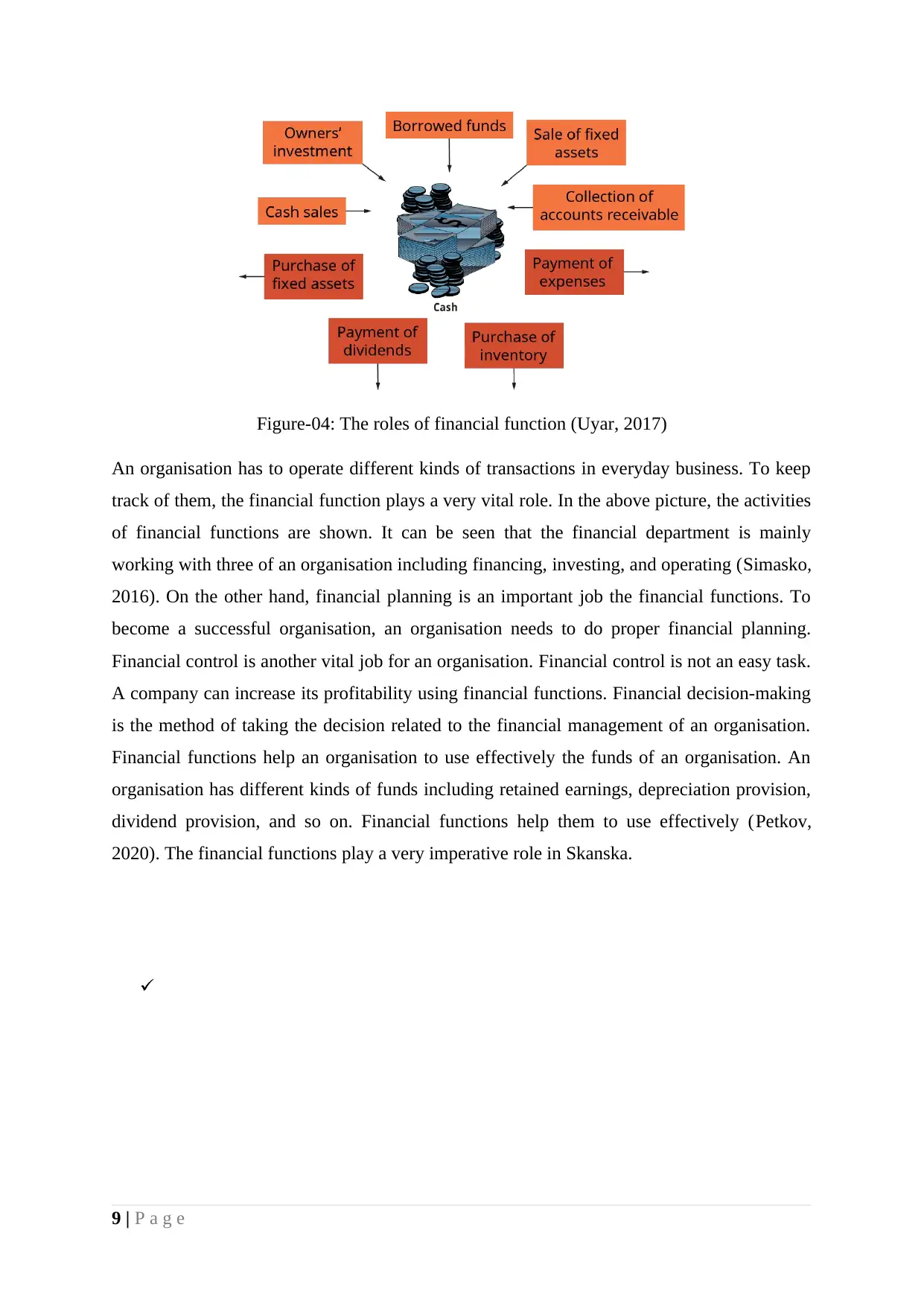
Figure-04: The roles of financial function (Uyar, 2017)
An organisation has to operate different kinds of transactions in everyday business. To keep
track of them, the financial function plays a very vital role. In the above picture, the activities
of financial functions are shown. It can be seen that the financial department is mainly
working with three of an organisation including financing, investing, and operating (Simasko,
2016). On the other hand, financial planning is an important job the financial functions. To
become a successful organisation, an organisation needs to do proper financial planning.
Financial control is another vital job for an organisation. Financial control is not an easy task.
A company can increase its profitability using financial functions. Financial decision-making
is the method of taking the decision related to the financial management of an organisation.
Financial functions help an organisation to use effectively the funds of an organisation. An
organisation has different kinds of funds including retained earnings, depreciation provision,
dividend provision, and so on. Financial functions help them to use effectively (Petkov,
2020). The financial functions play a very imperative role in Skanska.
9 | P a g e
An organisation has to operate different kinds of transactions in everyday business. To keep
track of them, the financial function plays a very vital role. In the above picture, the activities
of financial functions are shown. It can be seen that the financial department is mainly
working with three of an organisation including financing, investing, and operating (Simasko,
2016). On the other hand, financial planning is an important job the financial functions. To
become a successful organisation, an organisation needs to do proper financial planning.
Financial control is another vital job for an organisation. Financial control is not an easy task.
A company can increase its profitability using financial functions. Financial decision-making
is the method of taking the decision related to the financial management of an organisation.
Financial functions help an organisation to use effectively the funds of an organisation. An
organisation has different kinds of funds including retained earnings, depreciation provision,
dividend provision, and so on. Financial functions help them to use effectively (Petkov,
2020). The financial functions play a very imperative role in Skanska.
9 | P a g e
⊘ This is a preview!⊘
Do you want full access?
Subscribe today to unlock all pages.

Trusted by 1+ million students worldwide
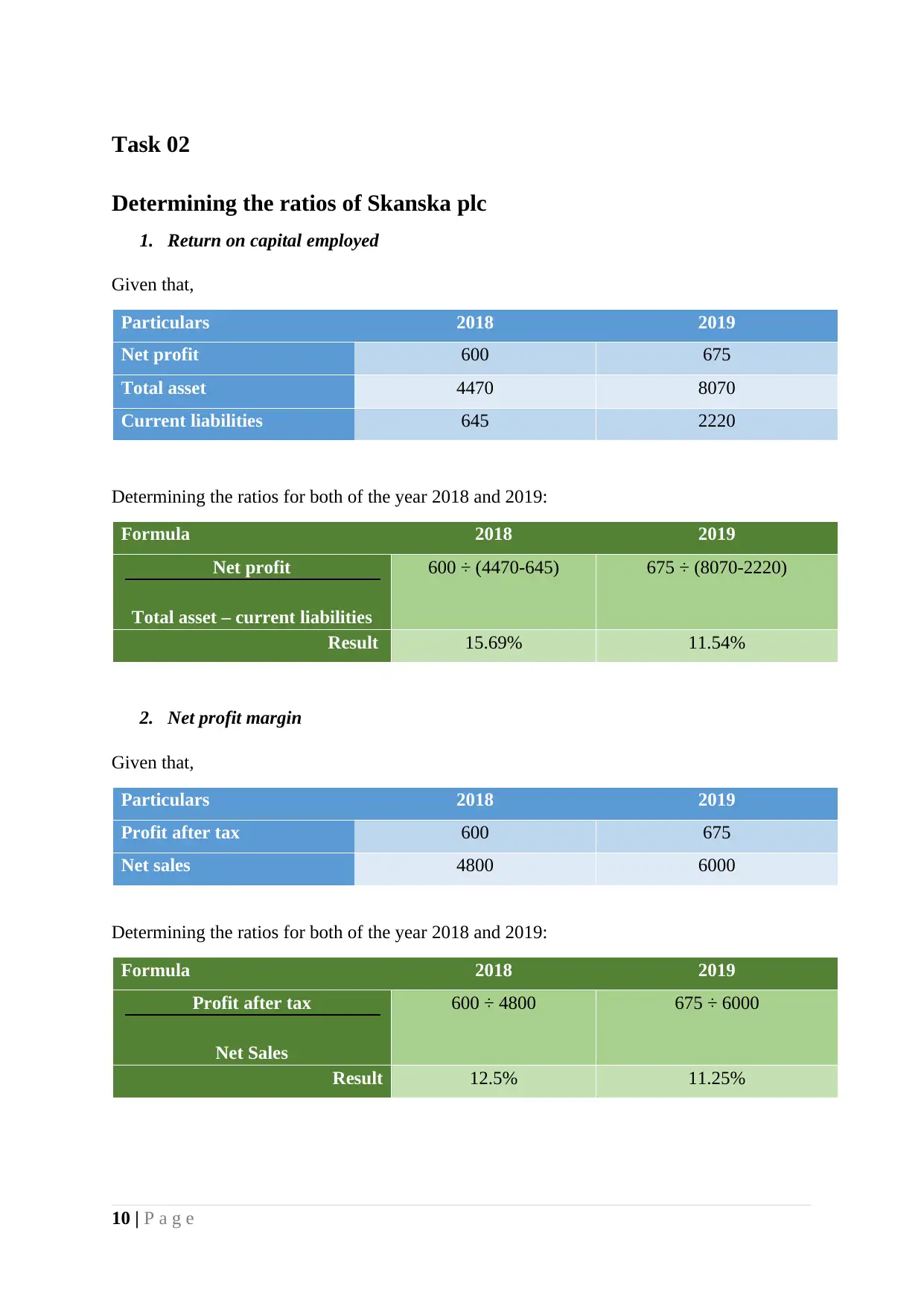
Task 02
Determining the ratios of Skanska plc
1. Return on capital employed
Given that,
Particulars 2018 2019
Net profit 600 675
Total asset 4470 8070
Current liabilities 645 2220
Determining the ratios for both of the year 2018 and 2019:
Formula 2018 2019
Net profit
Total asset – current liabilities
600 ÷ (4470-645) 675 ÷ (8070-2220)
Result 15.69% 11.54%
2. Net profit margin
Given that,
Particulars 2018 2019
Profit after tax 600 675
Net sales 4800 6000
Determining the ratios for both of the year 2018 and 2019:
Formula 2018 2019
Profit after tax
Net Sales
600 ÷ 4800 675 ÷ 6000
Result 12.5% 11.25%
10 | P a g e
Determining the ratios of Skanska plc
1. Return on capital employed
Given that,
Particulars 2018 2019
Net profit 600 675
Total asset 4470 8070
Current liabilities 645 2220
Determining the ratios for both of the year 2018 and 2019:
Formula 2018 2019
Net profit
Total asset – current liabilities
600 ÷ (4470-645) 675 ÷ (8070-2220)
Result 15.69% 11.54%
2. Net profit margin
Given that,
Particulars 2018 2019
Profit after tax 600 675
Net sales 4800 6000
Determining the ratios for both of the year 2018 and 2019:
Formula 2018 2019
Profit after tax
Net Sales
600 ÷ 4800 675 ÷ 6000
Result 12.5% 11.25%
10 | P a g e
Paraphrase This Document
Need a fresh take? Get an instant paraphrase of this document with our AI Paraphraser
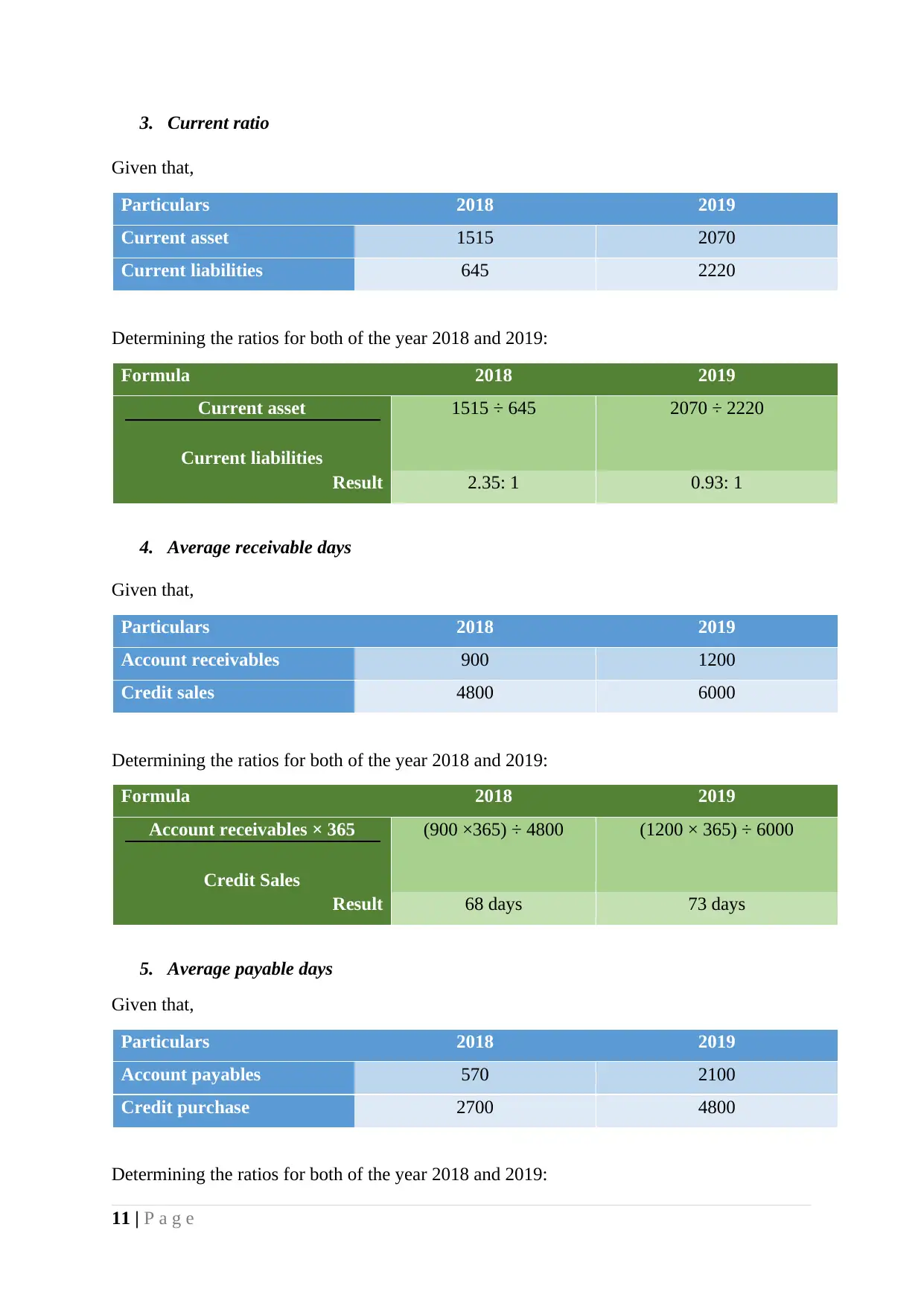
3. Current ratio
Given that,
Particulars 2018 2019
Current asset 1515 2070
Current liabilities 645 2220
Determining the ratios for both of the year 2018 and 2019:
Formula 2018 2019
Current asset
Current liabilities
1515 ÷ 645 2070 ÷ 2220
Result 2.35: 1 0.93: 1
4. Average receivable days
Given that,
Particulars 2018 2019
Account receivables 900 1200
Credit sales 4800 6000
Determining the ratios for both of the year 2018 and 2019:
Formula 2018 2019
Account receivables × 365
Credit Sales
(900 ×365) ÷ 4800 (1200 × 365) ÷ 6000
Result 68 days 73 days
5. Average payable days
Given that,
Particulars 2018 2019
Account payables 570 2100
Credit purchase 2700 4800
Determining the ratios for both of the year 2018 and 2019:
11 | P a g e
Given that,
Particulars 2018 2019
Current asset 1515 2070
Current liabilities 645 2220
Determining the ratios for both of the year 2018 and 2019:
Formula 2018 2019
Current asset
Current liabilities
1515 ÷ 645 2070 ÷ 2220
Result 2.35: 1 0.93: 1
4. Average receivable days
Given that,
Particulars 2018 2019
Account receivables 900 1200
Credit sales 4800 6000
Determining the ratios for both of the year 2018 and 2019:
Formula 2018 2019
Account receivables × 365
Credit Sales
(900 ×365) ÷ 4800 (1200 × 365) ÷ 6000
Result 68 days 73 days
5. Average payable days
Given that,
Particulars 2018 2019
Account payables 570 2100
Credit purchase 2700 4800
Determining the ratios for both of the year 2018 and 2019:
11 | P a g e
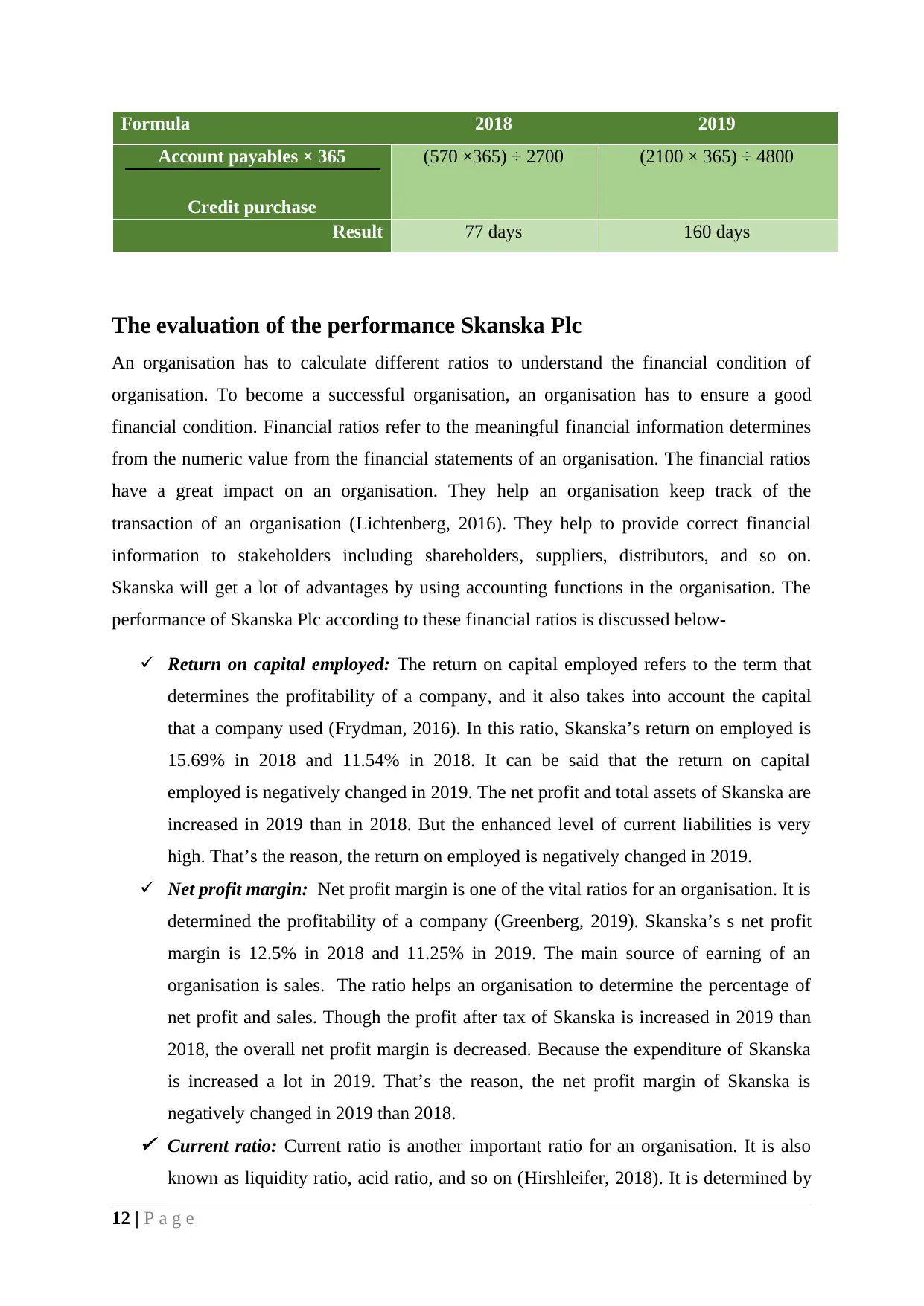
Formula 2018 2019
Account payables × 365
Credit purchase
(570 ×365) ÷ 2700 (2100 × 365) ÷ 4800
Result 77 days 160 days
The evaluation of the performance Skanska Plc
An organisation has to calculate different ratios to understand the financial condition of
organisation. To become a successful organisation, an organisation has to ensure a good
financial condition. Financial ratios refer to the meaningful financial information determines
from the numeric value from the financial statements of an organisation. The financial ratios
have a great impact on an organisation. They help an organisation keep track of the
transaction of an organisation (Lichtenberg, 2016). They help to provide correct financial
information to stakeholders including shareholders, suppliers, distributors, and so on.
Skanska will get a lot of advantages by using accounting functions in the organisation. The
performance of Skanska Plc according to these financial ratios is discussed below-
Return on capital employed: The return on capital employed refers to the term that
determines the profitability of a company, and it also takes into account the capital
that a company used (Frydman, 2016). In this ratio, Skanska’s return on employed is
15.69% in 2018 and 11.54% in 2018. It can be said that the return on capital
employed is negatively changed in 2019. The net profit and total assets of Skanska are
increased in 2019 than in 2018. But the enhanced level of current liabilities is very
high. That’s the reason, the return on employed is negatively changed in 2019.
Net profit margin: Net profit margin is one of the vital ratios for an organisation. It is
determined the profitability of a company (Greenberg, 2019). Skanska’s s net profit
margin is 12.5% in 2018 and 11.25% in 2019. The main source of earning of an
organisation is sales. The ratio helps an organisation to determine the percentage of
net profit and sales. Though the profit after tax of Skanska is increased in 2019 than
2018, the overall net profit margin is decreased. Because the expenditure of Skanska
is increased a lot in 2019. That’s the reason, the net profit margin of Skanska is
negatively changed in 2019 than 2018. Current ratio: Current ratio is another important ratio for an organisation. It is also
known as liquidity ratio, acid ratio, and so on (Hirshleifer, 2018). It is determined by
12 | P a g e
Account payables × 365
Credit purchase
(570 ×365) ÷ 2700 (2100 × 365) ÷ 4800
Result 77 days 160 days
The evaluation of the performance Skanska Plc
An organisation has to calculate different ratios to understand the financial condition of
organisation. To become a successful organisation, an organisation has to ensure a good
financial condition. Financial ratios refer to the meaningful financial information determines
from the numeric value from the financial statements of an organisation. The financial ratios
have a great impact on an organisation. They help an organisation keep track of the
transaction of an organisation (Lichtenberg, 2016). They help to provide correct financial
information to stakeholders including shareholders, suppliers, distributors, and so on.
Skanska will get a lot of advantages by using accounting functions in the organisation. The
performance of Skanska Plc according to these financial ratios is discussed below-
Return on capital employed: The return on capital employed refers to the term that
determines the profitability of a company, and it also takes into account the capital
that a company used (Frydman, 2016). In this ratio, Skanska’s return on employed is
15.69% in 2018 and 11.54% in 2018. It can be said that the return on capital
employed is negatively changed in 2019. The net profit and total assets of Skanska are
increased in 2019 than in 2018. But the enhanced level of current liabilities is very
high. That’s the reason, the return on employed is negatively changed in 2019.
Net profit margin: Net profit margin is one of the vital ratios for an organisation. It is
determined the profitability of a company (Greenberg, 2019). Skanska’s s net profit
margin is 12.5% in 2018 and 11.25% in 2019. The main source of earning of an
organisation is sales. The ratio helps an organisation to determine the percentage of
net profit and sales. Though the profit after tax of Skanska is increased in 2019 than
2018, the overall net profit margin is decreased. Because the expenditure of Skanska
is increased a lot in 2019. That’s the reason, the net profit margin of Skanska is
negatively changed in 2019 than 2018. Current ratio: Current ratio is another important ratio for an organisation. It is also
known as liquidity ratio, acid ratio, and so on (Hirshleifer, 2018). It is determined by
12 | P a g e
⊘ This is a preview!⊘
Do you want full access?
Subscribe today to unlock all pages.

Trusted by 1+ million students worldwide
1 out of 16
Related Documents
Your All-in-One AI-Powered Toolkit for Academic Success.
+13062052269
info@desklib.com
Available 24*7 on WhatsApp / Email
![[object Object]](/_next/static/media/star-bottom.7253800d.svg)
Unlock your academic potential
Copyright © 2020–2025 A2Z Services. All Rights Reserved. Developed and managed by ZUCOL.



